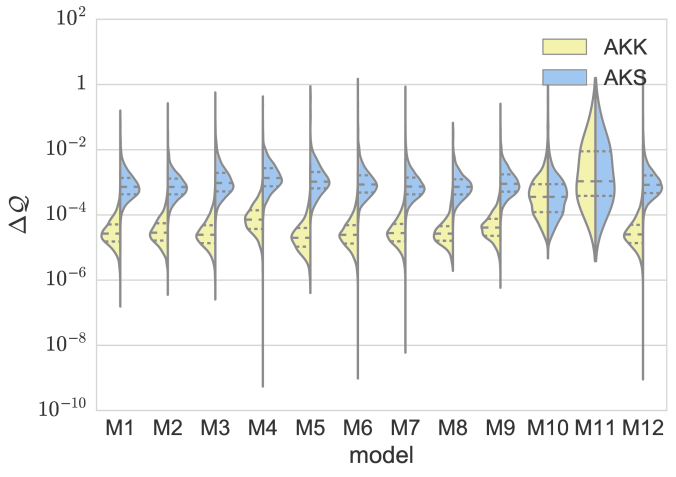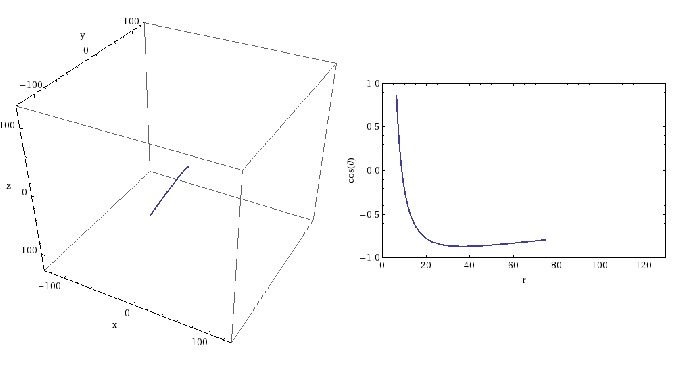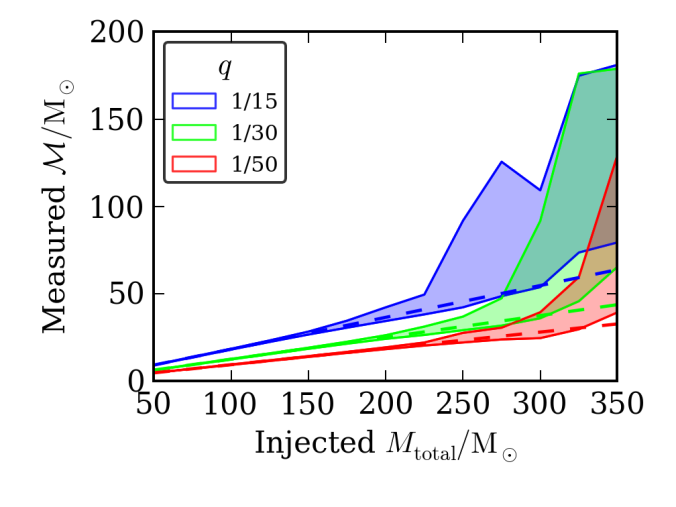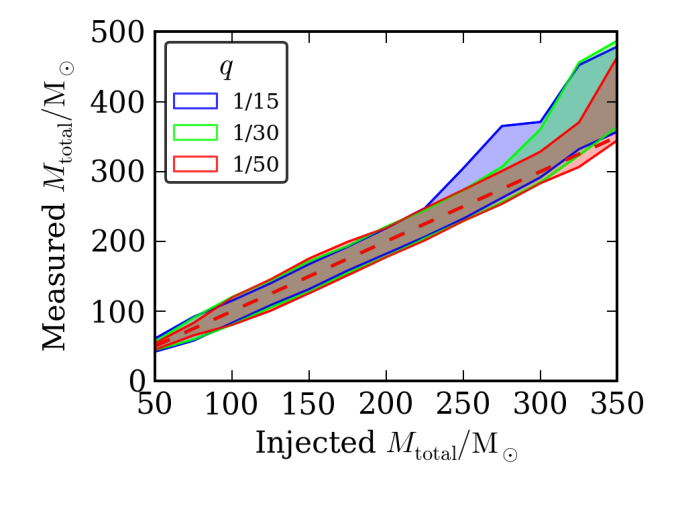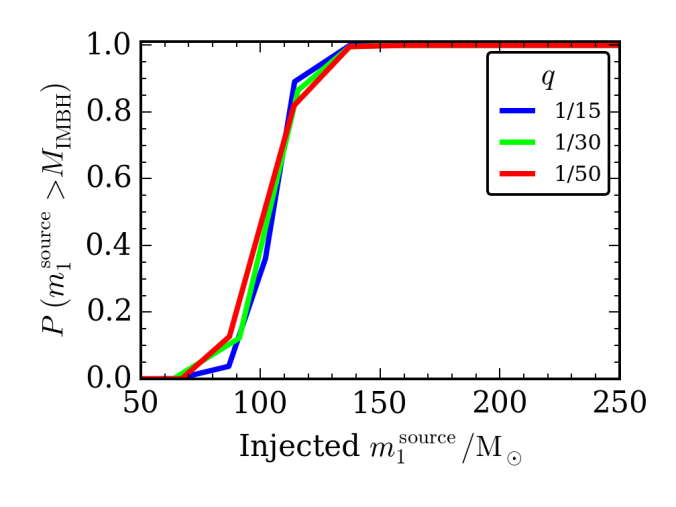What will be the next big thing in astronomy? One of the hard things about research is that you often don’t know what you will discover before you embark on an investigation. An idea might work out, or it might not, or along the way you might discover something unexpected which is far more interesting. As you might imagine, this can make laying definite plans difficult…
However, it is important to have plans for research. While you might not be sure of the outcome, it is necessary to weigh the risks and rewards associated with the probable results before you invest your time and taxpayers’ money!
To help with planning and prioritising, researchers in astrophysics often pull together white papers [bonus note]. These are sketches of ideas for future research, arguing why you think they might be interesting. These can then be discussed within the community to help shape the direction of the field. If other scientists find the paper convincing, you can build support which helps push for funding. If there are gaps in the logic, others can point these out to ave you heading the wrong way. This type of consensus building is especially important for large experiments or missions—you don’t want to spend a billion dollars on something unless you’re really sure it is a good idea and lots of people agree.
I have been involved with a few white papers recently. Here are some key ideas for where research should go.
Ground-based gravitational-wave detectors: The next generation
We’ve done some awesome things with Advanced LIGO and Advanced Virgo. In just a couple of years we have revolutionized our understanding of binary black holes. That’s not bad. However, our current gravitational-wave observatories are limited in what they can detect. What amazing things could we achieve with a new generation of detectors?
It can take decades to develop new instruments, therefore it’s important to start thinking about them early. Obviously, what we would most like is an observatory which can detect everything, but that’s not feasible. In this white paper, we pick the questions we most want answered, and see what the requirements for a new detector would be. A design which satisfies these specifications would therefore be a solid choice for future investment.
Binary black holes are the perfect source for ground-based detectors. What do we most want to know about them?
- How many mergers are there, and how does the merger rate change over the history of the Universe? We want to know how binary black holes are made. The merger rate encodes lots of information about how to make binaries, and comparing how this evolves compared with the rate at which the Universe forms stars, will give us a deeper understanding of how black holes are made.
- What are the properties (masses and spins) of black holes? The merger rate tells us some things about how black holes form, but other properties like the masses, spins and orbital eccentricity complete the picture. We want to make precise measurements for individual systems, and also understand the population.
- Where do supermassive black holes come from? We know that stars can collapse to produce stellar-mass black holes. We also know that the centres of galaxies contain massive black holes. Where do these massive black holes come from? Do they grow from our smaller black holes, or do they form in a different way? Looking for intermediate-mass black holes in the gap in-between will tells us whether there is a missing link in the evolution of black holes.
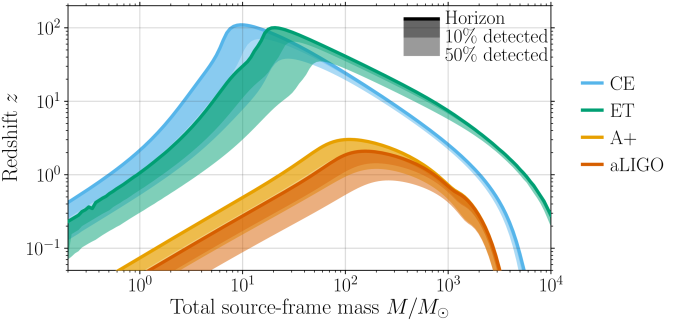
The detection horizon (the distance to which sources can be detected) for Advanced LIGO (aLIGO), its upgrade A+, and the proposed Cosmic Explorer (CE) and Einstein Telescope (ET). The horizon is plotted for binaries with equal-mass, nonspinning components. Adapted from Hall & Evans (2019).
What can we do to answer these questions?
- Increase sensitivity! Advanced LIGO and Advanced Virgo can detect a
binary out to a redshift of about
. The planned detector upgrade A+ will see them out to redshift
. That’s pretty impressive, it means we’re covering 10 billion years of history. However, the peak in the Universe’s star formation happens at around
, so we’d really like to see beyond this in order to measure how the merger rate evolves. Ideally we would see all the way back to cosmic dawn at
when the Universe was only 200 million years old and the first stars light up.
- Increase our frequency range! Our current detectors are limited in the range of frequencies they can detect. Pushing to lower frequencies helps us to detect heavier systems. If we want to detect intermediate-mass black holes of
we need this low frequency sensitivity. At the moment, Advanced LIGO could get down to about
. The plot below shows the signal from a
binary at
. The signal is completely undetectable at
.

The gravitational wave signal from the final stages of inspiral, merger and ringdown of a two 100 solar mass black holes at a redshift of 10. The signal chirps up in frequency. The colour coding shows parts of the signal above different frequencies. Part of Figure 2 of the Binary Black Holes White Paper.
- Increase sensitivity and frequency range! Increasing sensitivity means that we will have higher signal-to-noise ratio detections. For these loudest sources, we will be able to make more precise measurements of the source properties. We will also have more detections overall, as we can survey a larger volume of the Universe. Increasing the frequency range means we can observe a longer stretch of the signal (for the systems we currently see). This means it is easier to measure spin precession and orbital eccentricity. We also get to measure a wider range of masses. Putting the improved sensitivity and frequency range together means that we’ll get better measurements of individual systems and a more complete picture of the population.
How much do we need to improve our observatories to achieve our goals? To quantify this, lets consider the boost in sensitivity relative to A+, which I’ll call . If the questions can be answered with
, then we don’t need anything beyond the currently planned A+. If we need a slightly larger
, we should start investigating extra ways to improve the A+ design. If we need much larger
, we need to think about new facilities.
The plot below shows the boost necessary to detect a binary (with equal-mass nonspinning components) out to a given redshift. With a boost of (blue line) we can survey black holes around
–
across cosmic time.

The boost factor (relative to A+) needed to detect a binary with a total mass
out to redshift
. The binaries are assumed to have equal-mass, nonspinning components. The colour scale saturates at
. The blue curve highlights the reach at a boost factor of
. The solid and dashed white lines indicate the maximum reach of Cosmic Explorer and the Einstein Telescope, respectively. Part of Figure 1 of the Binary Black Holes White Paper.
The plot above shows that to see intermediate-mass black holes, we do need to completely overhaul the low-frequency sensitivity. What do we need to detect a binary at
? If we parameterize the noise spectrum (power spectral density) of our detector as
with a lower cut-off frequency of
, we can investigate the various possibilities. The plot below shows the possible combinations of parameters which meet of requirements.

Requirements on the low-frequency noise power spectrum necessary to detect an optimally oriented intermediate-mass binary black hole system with two 100 solar mass components at a redshift of 10. Part of Figure 2 of the Binary Black Holes White Paper.
To build up information about the population of black holes, we need lots of detections. Uncertainties scale inversely with the square root of the number of detections, so you would expect few percent uncertainty after 1000 detections. If we want to see how the population evolves, we need these many per redshift bin! The plot below shows the number of detections per year of observing time for different boost factors. The rate starts to saturate once we detect all the binaries in the redshift range. This is as good as you’ll ever going to get.

Expected rate of binary black hole detections per redshift bin as a function of A+ boost factor
for three redshift bins. The merging binaries are assumed to be uniformly distributed with a constant merger rate roughly consistent with current observations: the solid line is about the current median, while the dashed and dotted lines are roughly the 90% bounds. Figure 3 of the Binary Black Holes White Paper.
Looking at the plots above, it is clear that A+ is not going to satisfy our requirements. We need something with a boost factor of : a next-generation observatory. Both the Cosmic Explorer and Einstein Telescope designs do satisfy our goals.
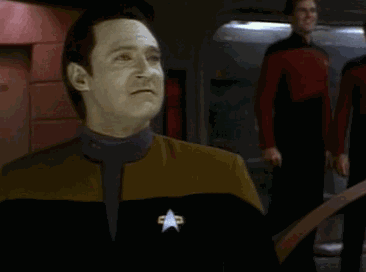
Data is pleased. Credit: Paramount
Title: Deeper, wider, sharper: Next-generation ground-based gravitational-wave observations of binary black holes
arXiv: 1903.09220 [astro-ph.HE]
Contribution level: ☆☆☆☆☆ Leading author
Theme music: Daft Punk
Extreme mass ratio inspirals are awesome
We have seen gravitational waves from a stellar-mass black hole merging with another stellar-mass black hole, can we observe a stellar-mass black hole merging with a massive black hole? Yes, these are a perfect source for a space-based gravitational wave observatory. We call these systems extreme mass-ratio inspirals (or EMRIs, pronounced em-rees, for short) [bonus note].
Having such an extreme mass ratio, with one black hole much bigger than the other, gives EMRIs interesting properties. The number of orbits over the course of an inspiral scales with the mass ratio: the more extreme the mass ratio, the more orbits there are. Each of these gives us something to measure in the gravitational wave signal.

A short section of an orbit around a spinning black hole. While inspirals last for years, this would represent only a few hours around a black hole of mass . The position is measured in terms of the gravitational radius
. The innermost stable orbit for this black hole would be about
. Part of Figure 1 of the EMRI White Paper.
As EMRIs are so intricate, we can make exquisit measurements of the source properties. These will enable us to:
- Measure the masses of both black holes to better than 10% precision
- Reconstruct the mass distribution of massive black holes out to redshift
- Measure massive black hole spins to a precision of better than 0.001, giving us an insight into how they formed
- Perform precision tests of the no-hair theorem describing black holes in general relativity, and test alternative theories of gravity in the strong-field regime
- Cross-correlate locations with galaxy catalogues to measure the expansion of the Universe
Event rates for EMRIs are currently uncertain: there could be just one per year or thousands. From the rate we can figure out the details of what is going in in the nuclei of galaxies, and what types of objects you find there.
With EMRIs you can unravel mysteries in astrophysics, fundamental physics and cosmology.
Have we sold you that EMRIs are awesome? Well then, what do we need to do to observe them? There is only one currently planned mission which can enable us to study EMRIs: LISA. To maximise the science from EMRIs, we have to support LISA.

As an aspiring scientist, Lisa Simpson is a strong supporter of the LISA mission. Credit: Fox
Title: The unique potential of extreme mass-ratio inspirals for gravitational-wave astronomy
arXiv: 1903.03686 [astro-ph.HE]
Contribution level: ☆☆☆☆☆ Leading author
Theme music: Muse
Bonus notes
White paper vs journal article
Since white papers are proposals for future research, they aren’t as rigorous as usual academic papers. They are really attempts to figure out a good question to ask, rather than being answers. White papers are not usually peer reviewed before publication—the point is that you want everybody to comment on them, rather than just one or two anonymous referees.
Whilst white papers aren’t quite the same class as journal articles, they do still contain some interesting ideas, so I thought they still merit a blog post.
Recycling
I have blogged about EMRIs before, so I won’t go into too much detail here. It was one of my former blog posts which inspired the LISA Science Team to get in touch to ask me to write the white paper.






